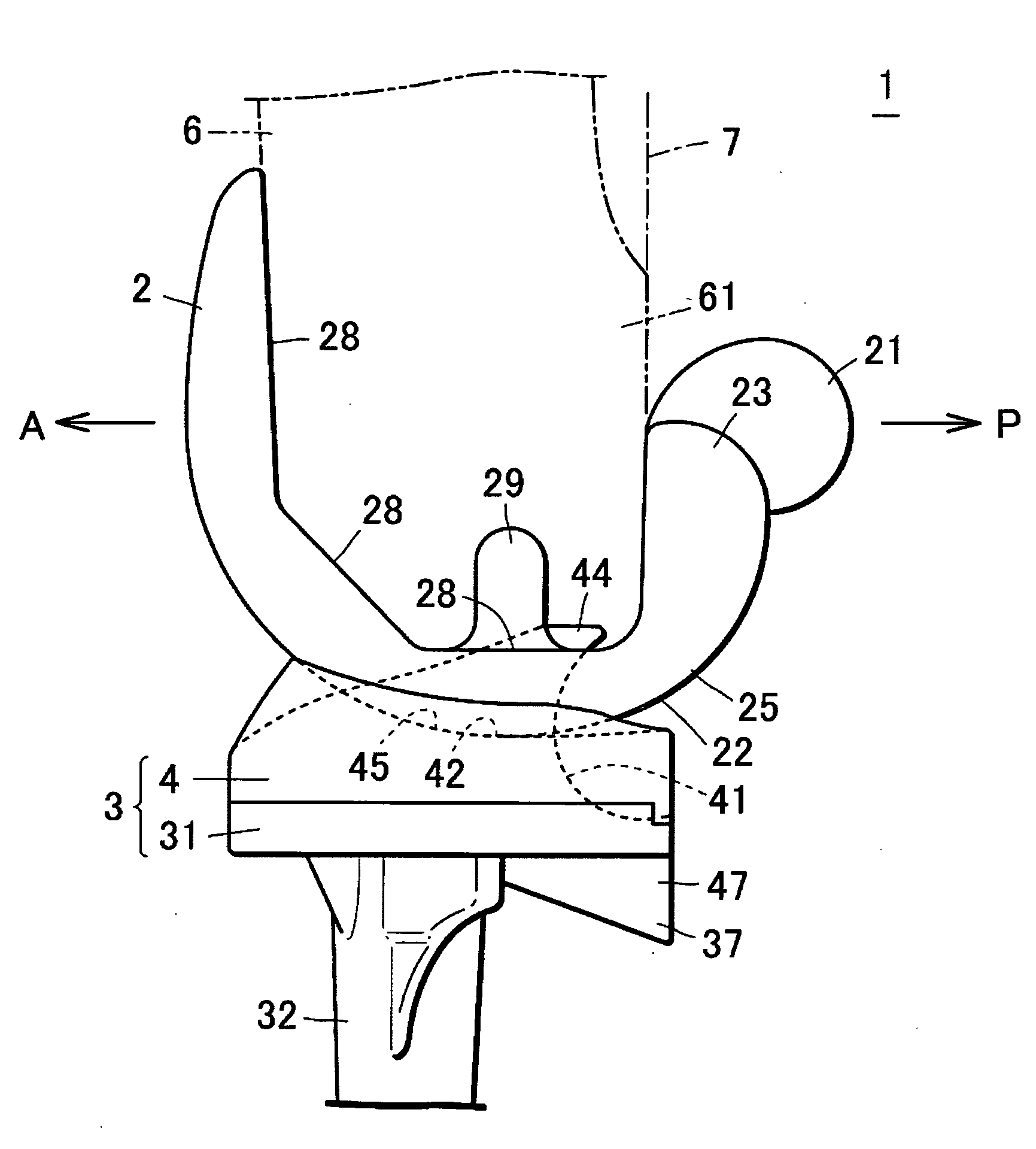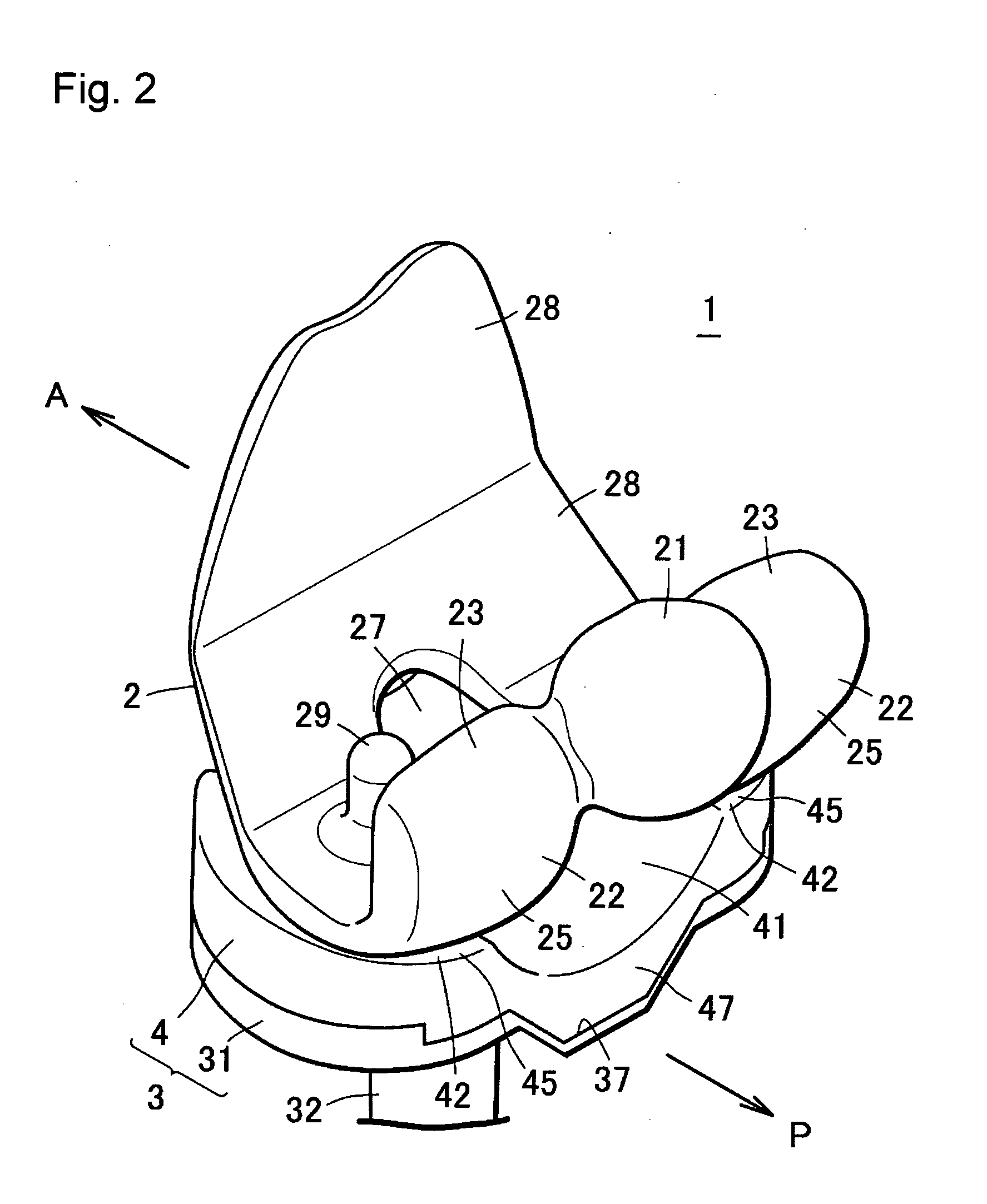Artificial knee joint
a knee joint and artificial technology, applied in knee joints, prostheses, medical science, etc., can solve the problems of increasing the possibility of fracture after the operation, and the excision of the tibia is more extensiv
- Summary
- Abstract
- Description
- Claims
- Application Information
AI Technical Summary
Benefits of technology
Problems solved by technology
Method used
Image
Examples
first embodiment
[0071]An artificial knee joint 1 of the present invention comprises a femoral component 2 fixed onto the distal portion of the femur and a tibial component 3 fixed onto the proximal portion of the tibia as shown in FIGS. 1 through 5.
[0072]The femoral component 2 comprises two femoral articular surfaces 25 of bulging and curved shapes, and a cam 21 of spheroidal or substantially cylindrical shape that is provided on the rear end 23 of the femoral articular surface 25 and protrudes from the femoral articular surface 25.
[0073]The tibial component 3 comprises a tibial tray 31 fixed onto the proximal portion of the tibia and an insert plate 4 fixed onto the top surface of the tibial tray 31.
[0074]The insert plate comprises two tibia articular surfaces 45 that make contact respectively with the two femoral articular surfaces 25 and a cam-receiving slide surface 41 that contacts the cam 21 and slides against the femoral component 2 in contact therewith.
[0075]When the knee is extended, the ...
second embodiment
[0098]The artificial knee joint of this embodiment comprises the femoral component 2 and the tibial component 3 similarly to the first embodiment, although the cam 21 is fixed onto the rear end 23 of the femoral component 2 so as to be slidable, and the amount of offset can be adjusted by changing the amount of protrusion of the cam 21 beyond the femoral articular surface 25.
[0099]A cam hole 26 is formed on the rear end 23 of the femoral component 2 as shown in FIG. 10, and the cam 21 is secured by inserting the cam stem 24 into the cam hole 26. The cam stem 24 and the cam hole 26 are secured together by forming an engaging mechanism on the surface of the cam stem 24 and on the medial surface of the cam hole 26, or by employing separate engagement members. Also the position of the cam stem 24 within the cam hole 26 can be changed by releasing the members from engagement, so as to move the cam stem 24, for example, to the position of cam stem 24′. Fixing the cam stem 24′ in the cam h...
third embodiment
[0102]The artificial knee joint of this embodiment comprises the femoral component 2 and the tibial component 3 similarly to the first embodiment, but is characterized in that the insert plate has a protrusion that inclines downward provided on the back surface at the mid position corresponding to the cam-receiving slide surface, and the tibial tray has a recess that accommodates the protrusion that tilts downward.
[0103]The artificial knee joint 1 of the present invention enables the knee to bend by means of the first sliding state and the second sliding state, while repetition of the sliding motion causes the insert plate 4 to wear. Therefore, it is necessary to set the thickness of the insert plate 4 so that the distance between the tibial articular surface 45 and the bottom of the cam-receiving slide surface 41 is not less than a predetermined thickness t that is set by taking the wear loss into account.
[0104]FIG. 12(B) shows the artificial knee joint 1 having the insert plate 4 ...
PUM
 Login to View More
Login to View More Abstract
Description
Claims
Application Information
 Login to View More
Login to View More - R&D
- Intellectual Property
- Life Sciences
- Materials
- Tech Scout
- Unparalleled Data Quality
- Higher Quality Content
- 60% Fewer Hallucinations
Browse by: Latest US Patents, China's latest patents, Technical Efficacy Thesaurus, Application Domain, Technology Topic, Popular Technical Reports.
© 2025 PatSnap. All rights reserved.Legal|Privacy policy|Modern Slavery Act Transparency Statement|Sitemap|About US| Contact US: help@patsnap.com



